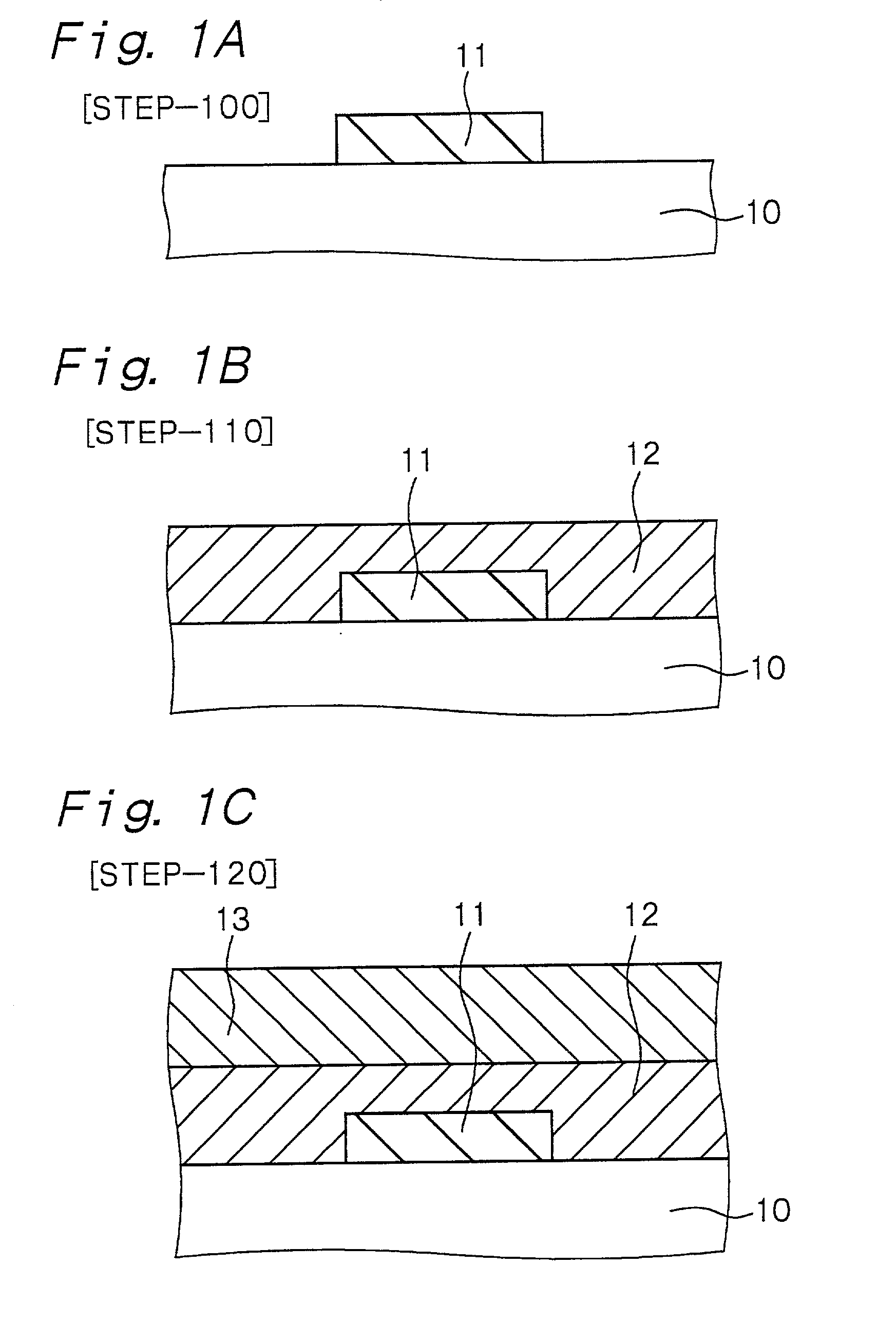[0017] Further, it is a second object of the present invention to provide a wiring structure in a semiconductor device, which, in addition to achieving the above first object, can prevent a refractory metal layer from undergoing cracking and is free from the inhibition of growth of the refractory metal layer, and a method for forming the wiring structure.
[0018] It is further a third object of the present invention to provide a wiring structure in a semiconductor device, which, in addition to achieving the above first object, can reliably prevent the adverse influence caused by the gas released from an insulating layer composed of a low dielectric constant material and is free from the inhibition of growth of the refractory metal layer, and a method for forming the wiring structure.
[0027] In the method for forming a wiring structure in a semiconductor device in the present invention, for achieving the above third object, preferably, the step (c) comprises a step of forming the thin layer of a metal or a metal compound on the barrier metal layer by an ionized sputtering method or a long throw sputtering method, and the above step (d) comprises a step of forming a refractory metal layer on the thin layer by a chemical vapor deposition method to fill the inside(s) of the opening portion and / or the trench portion with the refractory metal layer. This method for forming a wiring structure in a semiconductor device, provided by the present invention, will be referred to as a method for forming a wiring structure in a semiconductor device according to the second aspect of the present invention for the convenience. In this case, the temperature for heating the insulating layer during the formation of the refractory metal layer is required to be lower than the pyrolysis initiation temperature of the low dielectric constant material constituting the insulating layer. The above ionized sputtering method refers to a sputtering method in which particles sputtered from a target are passed through a plasma having an electron density of 10.sup.10 to 10.sup.12 cm.sup.-3 and the sputtered particles ionized by their collision with the plasma are directed perpendicularly to the insulating layer with a bias voltage applied to the substratum, which method can improve the coverage on the opening portion and / or the trench portion. The above long throw sputtering method refers to a sputtering method in which the distance between the target and the substratum is increased to intensify the perpendicular directionality of the sputtered particles to the insulating layer, which method can also improve the coverage on the opening portion and / or the trench portion.
[0042] In the present invention, the thin layer is composed of a metal or a metal compound which is less easily oxidizable than a material constituting the barrier metal layer, the thin layer corresponding to an underlayer for forming the refractory metal layer is less easily oxidizable, and there can be therefore avoided the problem that it is difficult to form the refractory metal layer.
[0043] In the wiring structure in a semiconductor device or the method for forming the wiring structure according to the first aspect of the present invention, the refractory metal layer having a tensile stress is formed on the thin layer having a compression stress, and the tensile stress of the refractory metal layer is therefore offset, so that the cracking of the refractory metal layer can be effectively prevented.
[0044] Further, in the wiring structure in a semiconductor device or the method for forming the wiring structure according to the second aspect of the present invention, the thin layer of a metal or a metal compound is formed on the barrier metal layer by the ionized sputtering method or the long throw sputtering method in which the directionality of sputtered particles are intensified, so that the coverage of the thin layer in the bottom of the opening portion and / or the trench portion can be improved. Further, for example, if a bias is applied to the substratum, the thin layer deposited in the bottom of the opening portion and / or the trench portion is re-sputtered, and as a result, the coverage of the thin layer on the inner wall surface(s) of the opening portion and / or the trench portion can be improved. Moreover, the thin layer is composed of a material which is less easily oxidizable than a material constituting the barrier metal layer. Therefore, not only the oxidation of the barrier metal layer can be prevented when the refractory metal layer is formed on the thin layer by a CVD method, but also the thin layer works as a barrier against gas released from the low dielectric constant material, and the process gases which the CVD method uses cannot be inhibited from entering the opening portion and / or the trench portion formed in the insulating layer composed of the low dielectric constant material. Therefore, the process gases are easily adsorbed on, and dissociated from, the thin layer, so that the opening portion and / or the trench portion can be reliably filled with the refractory metal layer. Further, if the thin layer is composed of the same refractory metal as the refractory metal which is to form the refractory metal layer to be formed on the thin layer, for example, if the thin layer is composed of tungsten, crystal nuclei of tungsten are easily formed on the thin layer, and the opening portion and / or the trench portion can be more reliably filled with the refractory metal layer. The above thin layer can therefore constitute an underlayer for forming the refractory metal layer according to a CVD method.
 Login to View More
Login to View More 


